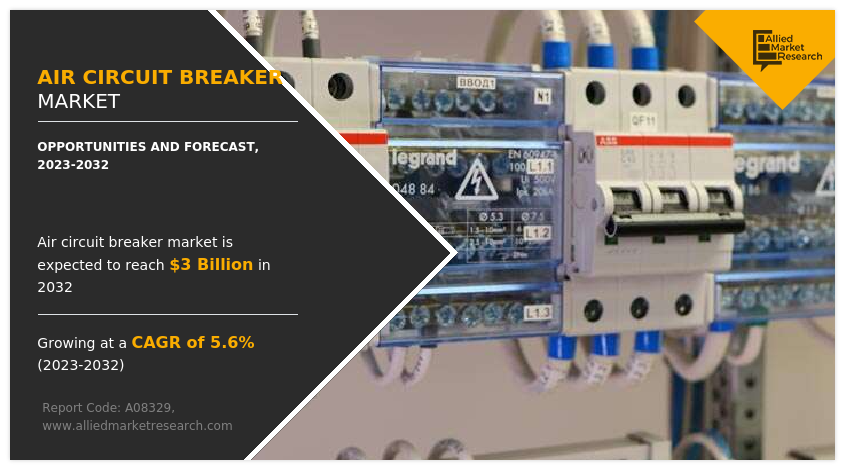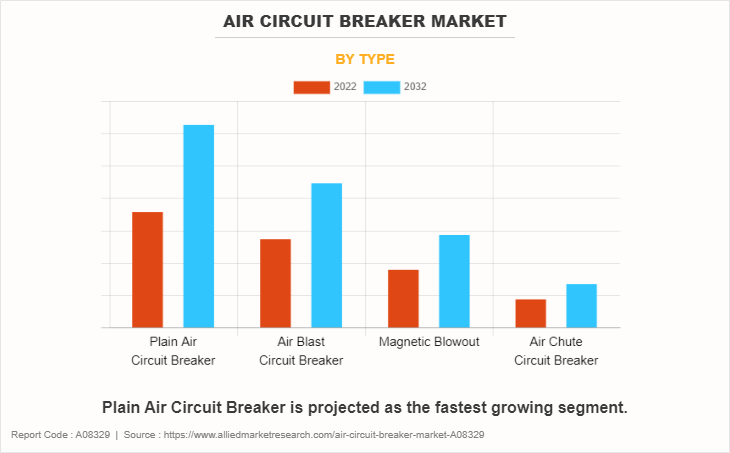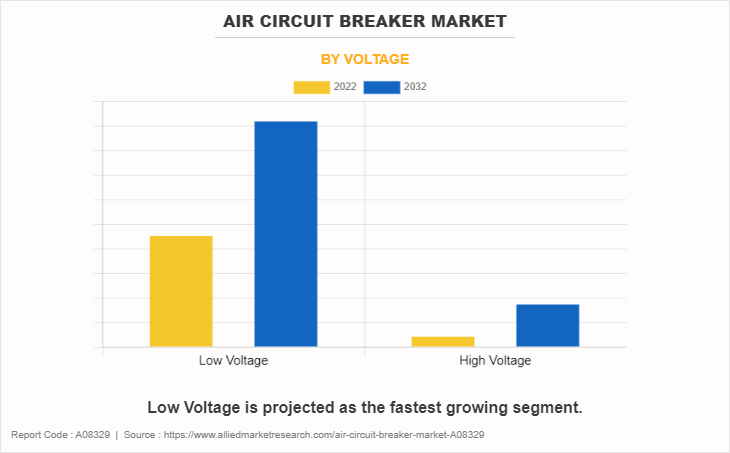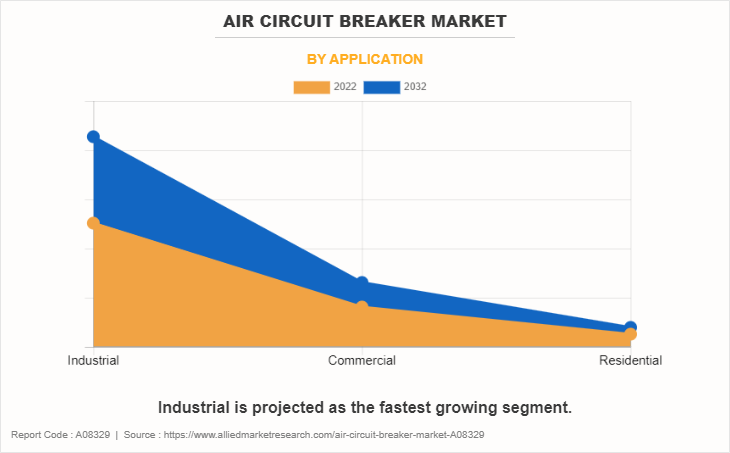Air Circuit Breaker Market Research, 2032
The global air circuit breaker market was valued at $1.8 billion in 2022, and is projected to reach $3.0 billion by 2032, growing at a CAGR of 5.6% from 2023 to 2032.
Report Key Highlighters:
- The air circuit breaker market study covers 20 countries. The research includes a segment analysis of each country in terms of value ($Million) for the projected period 2023-2032.
- The study integrated high-quality data, professional opinions and analysis, and critical independent perspectives. The research approach is intended to provide a balanced view of global markets and to assist stakeholders in making educated decisions in order to achieve their most ambitious growth objectives.
- Over 3,700 product literature, annual reports, industry statements, and other comparable materials from major industry participants were reviewed to gain a better understanding of the market.
- The air circuit breaker market is highly fragmented, with several players including ABB, alfanar Group, CNC ELECTRIC GROUP CO., LTD., Eaton, Havells India Ltd., Hitachi, Ltd., Mitsubishi Electric Corporation, Schneider Electric, Siemens, and WEG.

An air circuit breaker (ACB) is a crucial electrical component that automatically cuts off power to a circuit when abnormal conditions arise, protecting it from overloads and short circuits. It operates by creating a high-velocity airflow in the arc quenching medium, which is air, to rapidly extinguish the electrical arc that forms during a circuit disruption. The ability to withstand high currents and robust breaking capacities are characteristics that make ACBs dependable and adaptable parts of electrical systems, leading to rise in air circuit breaker market trends. Furthermore, they are widely used in industrial, commercial, and residential environments. They protect vital equipment and ensure the general stability and safety of electrical networks.
The surge in demand for renewable energy is poised to drive significant expansion in the air circuit breaker market size.
Rise in demand for renewable energy drives the growth of the air circuit breaker market. This increase is the evidence of global initiatives to switch to ecologically friendly and sustainable energy sources. According to the International Renewable Energy Agency (IRENA), the capacity for renewable energy rose by 9.6% globally in 2022. Ninety percent of the net additions came from solar and wind power, with nearly half coming from Asia, in 2022.
Furthermore, approximately 90% of all new renewable energy installations are expected to be made up of wind and solar PV by 2022, with annual additions projected to increase up from 350 GW in the main case to 400 GW in the accelerated case. Renewable energy is growing in demand as nations aim to reduce their reliance on fossil fuels and decrease the effects of climate change. ACBs play a crucial role in maintaining the efficiency, safety, and dependability of the evolving electrical infrastructure.
The weather and the time of the day cause variations in solar and wind energy. This intermittency requires complex protective methods and presents challenges for maintaining grid stability. ACBs are excellent at providing the necessary overcurrent and short-circuit protection to enable the seamless integration of renewable energy sources into the current power networks. Their ability to respond quickly to electrical disturbances and malfunctions is crucial for safeguarding equipment and maintaining the overall reliability of the power system.
In addition, the size and complexity of these installations require reliable electrical protection systems as renewable energy projects continue to spread across the globe. Air circuit breakers are suitable for large-scale applications, such solar power plants and wind farms, where they are the vital components of the protection system leading to increase in air circuit breaker market forecast.
ACBs withstand the large currents produced by these renewable energy sources due to their high breaking capacity, which also makes it possible to quickly fix any potential defects or disruptions, reduce downtime and increase energy output. Furthermore, air circuit breakers are in high demand due in significant measure to the growth of distributed energy generation. There is an increased demand for dependable and efficient localized protection against electrical failures due to the rise in both residential and commercial solar installations.
The air circuit breaker market analysis shows that these products offer continuous and flexible protection in the dynamic landscape of decentralized energy generation, making them suitable for integration into a wide range of situations, from private residences to immense industrial complexes.
The need for advanced air circuit breakers is further fueled by the focus on smart grid technologies and grid modernization to allow for the incorporation of renewable energy. Smart grids depend on intelligent devices for effective energy management, real-time monitoring, and control. Digital control and monitoring air circuit breakers meet the demands for modern grid infrastructure, providing protection while also enhancing the overall intelligence and resilience of the power distribution network. Thus, an increase in demand for renewable energy boosts the growth of the air circuit breaker market.
The lucrative use of ACBs in various end-use industries is poised to be a significant driver for the air circuit breaker market share.
The wide utilization of ACBs in various end-use industries drives the market growth. The mining, water & wastewater treatment, and pharmaceutical sectors depend significantly on the air circuit breakers to maintain the dependability and safety of their electrical systems. These various sectors rely on the seamless operation of vital equipment and processes, made possible by their robust design, adaptability, and efficiency in providing electrical protection. Air circuit breakers are essential in the mining industry due to the heavy machinery, complex processes, and adverse conditions that are present. Their main purpose is to protect against over currents and short circuits on vital equipment including transformers, conveyors, and motors.
Some of the manufacturers are offering their products that are used in the mining industry. For instance, Mine Line Pvt. Ltd., a manufacturer of mining electrical equipment, provides flameproof mining type ACB, that is designed for underground mining. They are used as a general defense against short circuits to safeguard plants and electrical circuits. These rotary, self-cleaning air circuit breakers are ideal for use underground in humid, dusty environments. In addition, these Breakers are suitable for use on any rating between 35Amps to 400Amps.
ACBs are ideally suited to the demanding and challenging environments found in mining operations owing to their sturdy design. These breakers protect the integrity of the electrical system by avoiding interruptions that harm public safety and reduce operational effectiveness. In addition, air circuit breakers offer vital electrical protection by quickly interrupting circuits during problems, which helps mining facilities continue to operate steadily and dependably.
The maintenance of water and wastewater treatment systems is essential to ensure environmental sustainability and public health. The complicated network of electrical equipment in these settings that oversees functions such as pumping, filtration, and control is protected by air circuit breakers. Continuous and efficient operation of pumps and motors is necessary to maintain water quality and meet treatment needs.
Air circuit breakers are used to stop electrical problems that might lead to downtime or system failures. They offer reliable safety against overcurrent and short circuit. ACBs contribute significantly to the overall functionality and dependability of critical systems in water treatment plants due to their versatility in meeting a broad range of requirements.
In the pharmaceutical industry, precision, dependability, and strict adherence to rules are essential, hence, the industry primarily relies on advanced electrical systems and control mechanisms. The pharmaceutical sector uses air circuit breakers as they offer reliable electrical protection for delicate equipment. ACBs quickly stop circuits in the case of an electrical failure, preventing disturbances that endanger the accuracy and quality required in the production of pharmaceuticals.
The air circuit breakers' dependability and efficiency meet the industry's need for regulated and consistent circumstances, which ensures compliance with regulations and preserves the quality of pharmaceutical manufacturing processes. Thus, the rise in demand of ACBs in various end-use industries including mining, water and wastewater treatment, and pharmaceuticals, boosts the growth of the air circuit breaker market.
Environmental concerns regarding the use of ACBs restrain market growth. Air circuit breakers produce waste and pollution during the manufacturing process. These procedures employ polymers, metals, and other materials that go through various coatings and treatments. Concerns with appropriate recycling and waste management procedures also arise from the disposal of obsolete or end-of-life circuit breakers, which will further damage the life cycle.
In addition, the requirement for insulating materials in air circuit breakers has raised questions, especially when those materials include dangerous compounds. For instance, if handled and disposed of improperly, some flame-retardant materials be hazardous to the environment. This forces manufacturers to examine eco-friendly, recyclable, or biodegradable insulating material alternatives.
The environmental impact of industrial products is closely examined due to the increased global focus on sustainability and green technologies. Manufacturers of air circuit breakers are facing growing pressure to include environmentally friendly materials and practices in their manufacturing processes. Strict rules and guidelines regarding recycling, waste minimization, and environmental effects have forced businesses to adapt their manufacturing processes to meet these changing needs. Thus, rise in environmental concerns hinders the growth of the air circuit breaker market.
Technological advancements in ACBs created a lucrative opportunity for the air circuit breaker market growth. The development of small and energy-efficient air circuit breakers is due to improvements in design engineering and insulation materials. A lower footprint and higher energy efficiency are a result of internal component miniaturization and optimization. ACBs are more desirable to industries looking to switch to more environment-friendly and energy-efficient electrical systems owing to these developments. These developments also fit with the industry trend toward sustainability and energy conservation.
Another technical advancement increasing the expansion of the air circuit breaker market opportunities is the use of microprocessor-based protective relays. These relays provide enhanced coordination, communication, and protection characteristics when combined with air circuit breakers. Digital technologies improve electrical parameter monitoring precision and allow for selective operation during failures. Consequently, this provides the most effective possible protection for electrical systems, reduces downtime, and improves overall system reliability.
Furthermore, arc quenching mechanism advancements mark a substantial technological advancement in the design of air circuit breakers. An ACB's conventional function during a fault is to stop the electric arc. Modern arc chutes and materials have been developed owing to technological developments that increase the effectiveness and speed at which ACBs extinguish arcs. Thus, technological advancements present an excellent opportunity for the expansion of the air circuit breaker market
The air circuit breaker market is segmented on the basis of type, voltage, application, and region. By type, the market is divided into plain air circuit breaker, air blast circuit breaker, magnetic blowout, and air chute circuit breaker. The air blast circuit breaker segment is further classified into axial blast air circuit breaker, cross blast air circuit breaker, and radial blast air circuit breaker. Depending on voltage, the market is bifurcated into low voltage and high voltage. On the basis of the application, it is categorized into industrial, commercial, and residential. Region-wise, the market is studied across North America, Europe, Asia-Pacific, and LAMEA.

The plain air circuit breaker segment accounted for the largest share in 2022 and is expected to register the highest CAGR of 6.1%. The plain air circuit breaker segment dominated the market and offered efficient electrical circuit protection owing to its dependability and simplicity of use. It is widely used and considered an excellent alternative for various industrial and commercial applications due to its minimal maintenance requirements and cost.

The low voltage segment accounted for the largest share in 2022 and is expected to register the highest CAGR of 5.9%. Low voltage air circuit breaker holds the largest market share due to its widespread use in commercial, industrial, and residential locations. It is a preferred option for a range of electrical distribution applications owing to its adaptability in handling lower voltage requirements. The cost, ease of installation, and compatibility with a broad variety of electrical systems are other factors that contribute to the low voltage segment's dominance.

The industrial segment accounted for the largest share in 2022 and is expected to register the highest CAGR of 5.8%. The industrial segment has the largest market share as air circuit breakers are essential to protect industrial gear and equipment. They are crucial for ensuring a continuous power supply in industrial settings owing to their robust design, high interrupting capacity, and dependability. Moreover, the dominance of the industrial segment is attributed to the increasing importance of industrial safety standards and the growing need for effective power distribution.

Asia-Pacific garnered the largest share in 2022. The market for air circuit breakers is dominated by the Asia-Pacific region due to the region's fast industrialization and urbanization, especially in developing nations like China and India. The frequent use of air circuit breakers in various applications is driven by rise in energy demand in the region and increased investments in infrastructure projects. The Asia-Pacific region's dominance is also a result of supportive government initiatives and policies for the development of electrical infrastructure.
The major players operating in the global air circuit breaker market are ABB, alfanar Group, CNC ELECTRIC GROUP CO., LTD., Eaton, Havells India Ltd., Hitachi, Ltd., Mitsubishi Electric Corporation, Schneider Electric, Siemens, and WEG. These players have adopted business expansion, partnership, and product launch as their key strategies to increase their market shares. Other players include CHINT Group, Fuji Electric Co., Ltd., General Electric, Hager Group, L&T Electrical & Automation, Legrand, and Noark Electricrope s.r.o.
Strategic Developments Undertaken By Key Players
In July 2023. Siemens launched additional versions of its innovative Sentron 3WA Power Circuit Breakers, also referred to as Air Circuit Breakers (ACBs). Customers may use Series 3WA3 across the globe as it complies with IEC 60947-2 and UL 1066 standards. This is particularly useful for OEMs and switchgear producers that are developing systems for the IEC and UL standardization sectors. The UL 489 market is the exclusive target for the 3WA2 series. The 3WA1 version is enhanced for IEC markets with the two new ACB model series. This product launch strengthened the demand for the air circuit breaker market.
In June 2023, Eaton expanded its manufacturing footprint in Puducherry to double the capacity of its medium voltage assembly. The 40,000 square foot new block includes production lines for air circuit breakers (ACBs) and molded case circuit breakers (MCCBs). Eaton's constant development in India has achieved a significant milestone with the expansion of the electrical plant, with a focus on strategic markets and electrical segments., leading to air circuit breaker market growth.
In January 2021, ABB India partnered with Surat Municipal Corporation (SMC), the governing body of Surat to further introduce innovative technologies and advance its goal of providing a 24/7 water supply throughout the city of Surat. ABB manufactures electrification equipment such as air circuit breakers (ACB), molded case circuit breakers (MCCB), miniature circuit breakers (MCBs), contactors, manual motor starters (MMS), overload relays (OLR), and pilot devices. This equipment reduces system downtime by effectively supplying the water management system with consistent, dependable power. This partnership boosted the growth of the air circuit breaker market.
Public Policies
Safety Standards: Regulatory bodies often establish safety standards that air circuit breakers must meet to ensure the protection of individuals and property. These standards include specifications related to insulation, temperature rise, short-circuit performance, and other safety features.
Product Certification: Authorities require air circuit breakers to undergo testing and certification by recognized organizations to confirm compliance with established standards. Certification ensures that products entering the market meet specific quality and safety criteria.
Environmental Regulations: Some regions have regulations addressing the environmental impact of electrical components, including air circuit breakers. Compliance with directives such as RoHS (Restriction of Hazardous Substances) be required to limit the use of certain hazardous materials in manufacturing.
Installation and Maintenance Guidelines: Regulatory guidelines specify proper installation and maintenance procedures for air circuit breakers. These guidelines ensure that these devices are installed correctly and maintained regularly to operate effectively and safely.
Grid Code Compliance: In some regions, air circuit breakers must adhere to grid codes that define the technical requirements for connecting to and operating within the electrical grid. Compliance with these codes ensures the stability and reliability of the overall power system.
Electromagnetic Compatibility (EMC): Regulations related to electromagnetic compatibility be in place to ensure that air circuit breakers do not cause interference with other electronic devices and systems. This involves meeting specific standards to minimize electromagnetic emissions and susceptibility.
Documentation and Labeling Requirements: Manufacturers be required to provide documentation, such as user manuals and technical specifications, accompanying air circuit breakers. In addition, labeling requirements specify the information that must be displayed on the product for user awareness and safety.
Recycling and End-of-Life Disposal: Regulations address the responsible disposal and recycling of air circuit breakers at the end of their lifecycle. Compliance with these guidelines helps manage electronic waste and promotes environmentally sustainable practices.
Impact Of Russia Ukraine War On The Air Circuit Breaker Market
Geopolitical tensions disrupt the supply chain for air circuit breakers, impacting manufacturing and distribution. If key suppliers or manufacturers are in a conflict zone or face trade restrictions, it leads to delays and shortages.
Wars often lead to volatility in commodity prices, affecting materials such as copper and aluminum used in air circuit breakers. Price fluctuations result in increased manufacturing costs, potentially influencing the pricing of these components.
Geopolitical conflicts create uncertainty in global markets, affecting economic stability. Businesses become more cautious, leading to a slowdown in investments and spending on projects that involve the installation of air circuit breakers.
Major conflicts disrupt infrastructure projects that involve the installation of electrical systems, including air circuit breakers. Delays or cancellations of projects have a direct impact on the demand for these components.
In times of geopolitical unrest, there is a slowdown in technological advancements and innovations within the air circuit breaker industry. Companies might redirect resources away from research and development, impacting the introduction of new features or improvements.
Geopolitical events lead to fluctuations in currency exchange rates, affecting international trade. Changes in currency values impact on the cost of importing or exporting air circuit breakers, influencing pricing and market dynamics.
Key Benefits For Stakeholders
- This report provides a quantitative analysis of the market segments, current trends, estimations, and dynamics of the air circuit breaker by type analysis from 2022 to 2032 to identify the prevailing air circuit breaker by type opportunities.
- The market research is offered along with information related to key drivers, restraints, and opportunities.
- Porter's five forces analysis highlights the potency of buyers and suppliers to enable stakeholders make profit-oriented business decisions and strengthen their supplier-buyer network.
- In-depth analysis of the air circuit breaker by type segmentation assists to determine the prevailing market opportunities.
- Major countries in each region are mapped according to their revenue contribution to the global market.
- Market player positioning facilitates benchmarking and provides a clear understanding of the present position of the market players.
- The report includes the analysis of the regional as well as global air circuit breaker by type trends, key players, market segments, application areas, and market growth strategies.
Air Circuit Breaker Market Report Highlights
| Aspects | Details |
| Market Size By 2032 | USD 3 billion |
| Growth Rate | CAGR of 5.6% |
| Forecast period | 2022 - 2032 |
| Report Pages | 300 |
| By Voltage |
|
| By Application |
|
| By Type |
|
| By Region |
|
| Key Market Players | Eaton, Hitachi, Ltd., alfanar Group, ABB, Havells India Ltd., WEG., Mitsubishi Electric Corporation, Siemens, Schneider Electric, CNC ELECTRIC GROUP CO.,LTD. |
Analyst Review
According to the insights of the CXOs of leading companies, air circuit breakers provide effective and dependable protection in high-voltage applications, as well as fast response times and high breaking capacities that makes them a preferred choice in various end-use sectors such as manufacturing, petrochemicals, transportation, construction, pharmaceuticals, and others. Moreover, ACBs are in high demand due to the increased emphasis on renewable energy on a global level and the increased funding of various infrastructure projects. The necessity of dependable circuit protection in the presence of intermittent renewable energy sources and the essential needs of modern commercial, residential, and industrial growth are the factors for the expansion of air circuit breaker market.
However, competition from alternative technologies such as vacuum circuit breakers and other solid-state devices, limits the adoption of ACBs. Environmental concerns related to the use of air circuit breaker also restrain market growth.
The CXOs further added that the technological advancements in the manufacturing of ACBs and ageing electrical infrastructure offer lucrative opportunities for growth. Moreover, the industry is characterized by a high number of new market entrants that seek to tap lucrative opportunities in the global market while existing players enter strategic collaborations to increase capacities and expand their reach into emerging markets. The acquisition, collaboration, and expansion activities in the industry have increased significantly over the past decade. Companies constantly seek to establish long-term contract agreements with trusted partners for sustainable business operations globally.
Air circuit breakers are widely used in industrial, commercial, and residential applications.
Technological advancements in the manufacturing of air circuit breakers and ageing electrical infrastructure are the upcoming trends of Air Circuit Breaker Market.
Asia-Pacific is the largest regional market for Air Circuit Breaker Market.
ABB, alfanar Group, CNC ELECTRIC GROUP CO.,LTD., Eaton, Havells India Ltd., Hitachi, Ltd., Mitsubishi Electric Corporation, Schneider Electric, Siemens, and WEG. are the top companies to hold the market share in Air Circuit Breaker Market.
The global air circuit breaker market was valued at $1.8 billion in 2022, and is projected to reach $3.0 billion by 2032, growing at a CAGR of 5.6% from 2023 to 2032.
Loading Table Of Content...
Loading Research Methodology...


